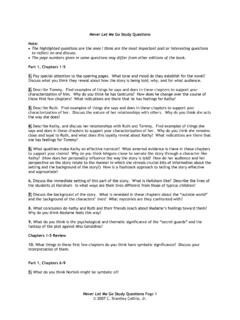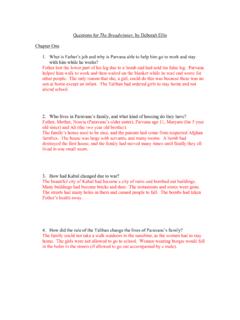Transcription of Weapons of Math Destruction: How Big Data Increases ...
1 More Advance Praise for Weapons OF math destruction Weapons of math destruction is a fantastic, plainspoken call to arms. Itacknowledges that models aren t going away: As a tool for identifying people indifficulty, they are amazing. But as a tool for punishing and disenfranchising,they re a nightmare. Cathy O Neil s book is important precisely because shebelieves in data science. It s a vital crash course in why we must interrogate thesystems around us and demand better. Cory Doctorow, author of Little Brother and co-editor of Boing Boing Many algorithms are slaves to the inequalities of power and prejudice. If youdon t want these algorithms to become your masters, read Weapons of MathDestruction by Cathy O Neil to deconstruct the latest growing tyranny of anarrogant establishment. Ralph Nader, author of Unsafe at Any Speed Next time you hear someone gushing uncritically about the wonders of Big Data,show them Weapons of math destruction . It ll be salutary. Felix Salmon, Fusion From getting a job to finding a spouse, predictive algorithms are silently shapingand controlling our destinies.
2 Cathy O Neil takes us on a journey of outrage andwonder, with prose that makes you feel like it s just a conversation. But it s animportant one. We need to reckon with technology. Linda Tirado, author of Hand to Mouth: Living in Bootstrap America Copyright 2016 by Cathy O Neil All rights reserved. Published in the United States by Crown, an imprint of the Crown PublishingGroup, a division of Penguin Random House LLC, New York. CROWN is a registered trademark and the Crown colophon is a trademark ofPenguin Random House LLC. Library of Congress Cataloging-in-Publication Data Name: O Neil, Cathy, author. Title: Weapons of math destruction : how big data Increases inequality andthreatens democracy / Cathy O Neil Description: First edition. | New York: Crown Publishers [2016] Identifiers: LCCN 2016003900 (print) | LCCN 2016016487 (ebook) | ISBN9780553418811 (hardcover) | ISBN 9780553418835 (pbk.) | ISBN 9780553418828(ebook) Subjects: LCSH: Big data Social aspects United States.
3 | Big data Politicalaspects United States. | Social indicators Mathematical models Moral andethical aspects. | Democracy United States. | United States Social conditions 21st century. Classification: LCC 064 2016 (print) | LCC (ebook) | dc23 LC record available at ISBN 9780553418811 Ebook ISBN 9780553418828 International Edition ISBN 9780451497338 Cover design by Elena Giavaldi a THIS BOOK IS DEDICATED TO ALL THE UNDERDOGS ACKNOWLEDGMENTS Thanks to my husband and kids for their incredible support. Thanks also to JohnJohnson, Steve Waldman, Maki Inada, Becky Jaffe, Aaron Abrams, Julie Steele,Karen Burnes, Matt LaMantia, Martha Poon, Lisa Radcliffe, Luis Daniel, andMelissa Bilski. Finally, thanks to the people without whom this book would notexist: Laura Strausfeld, Amanda Cook, Emma Berry, Jordan Ellenberg, StephenBaker, Jay Mandel, Sam Kanson-Benanav, and Ernie Davis. CONTENTS INTRODUCTION chapter 1 BOMB PARTS: What Is a Model? chapter 2 SHELL SHOCKED: My Journey of Disillusionment chapter 3 ARMS RACE: Going to College chapter 4 PROPAGANDA MACHINE: Online Advertising chapter 5 CIVILIAN CASUALTIES: Justice in the Age of Big Data chapter 6 INELIGIBLE TO SERVE: Getting a Job chapter 7 SWEATING BULLETS: On the Job chapter 8 COLLATERAL DAMAGE: Landing Credit chapter 9 NO SAFE ZONE: Getting Insurance chapter 10 THE TARGETED CITIZEN: Civic Life CONCLUSION Notes About the Author When I was a little girl, I used to gaze at the traffic out the car window and studythe numbers on license plates.
4 I would reduce each one to its basic elements thethe numbers on license plates. I would reduce each one to its basic elements theprime numbers that made it up. 45 = 3 x 3 x 5. That s called factoring, and it was myfavorite investigative pastime. As a budding math nerd, I was especially intrigued bythe primes. My love for math eventually became a passion. I went to math camp when I wasfourteen and came home clutching a Rubik s Cube to my chest. math provided aneat refuge from the messiness of the real world. It marched forward, its field ofknowledge expanding relentlessly, proof by proof. And I could add to it. I majoredin math in college and went on to get my PhD. My thesis was on algebraic numbertheory, a field with roots in all that factoring I did as a child. Eventually, I became atenure-track professor at Barnard, which had a combined math department withColumbia University. And then I made a big change. I quit my job and went to work as a quant for D. , a leading hedge fund.
5 In leaving academia for finance, I carried mathematicsfrom abstract theory into practice. The operations we performed on numberstranslated into trillions of dollars sloshing from one account to another. At first I wasexcited and amazed by working in this new laboratory, the global economy. But inthe autumn of 2008, after I d been there for a bit more than a year, it came crashingdown. The crash made it all too clear that mathematics, once my refuge, was not onlydeeply entangled in the world s problems but also fueling many of them. Thehousing crisis, the collapse of major financial institutions, the rise of unemployment all had been aided and abetted by mathematicians wielding magic s more, thanks to the extraordinary powers that I loved so much, math wasable to combine with technology to multiply the chaos and misfortune, addingefficiency and scale to systems that I now recognized as flawed. If we had been clear-headed, we all would have taken a step back at this point tofigure out how math had been misused and how we could prevent a similarcatastrophe in the future.
6 But instead, in the wake of the crisis, new mathematicaltechniques were hotter than ever, and expanding into still more domains. Theychurned 24/7 through petabytes of information, much of it scraped from socialmedia or e-commerce websites. And increasingly they focused not on themovements of global financial markets but on human beings, on us. Mathematiciansand statisticians were studying our desires, movements, and spending power. Theywere predicting our trustworthiness and calculating our potential as students,workers, lovers, criminals. This was the Big Data economy, and it promised spectacular gains. A computerprogram could speed through thousands of r sum s or loan applications in a secondprogram could speed through thousands of r sum s or loan applications in a secondor two and sort them into neat lists, with the most promising candidates on top. Thisnot only saved time but also was marketed as fair and objective. After all, it didn tinvolve prejudiced humans digging through reams of paper, just machinesprocessing cold numbers.
7 By 2010 or so, mathematics was asserting itself as neverbefore in human affairs, and the public largely welcomed it. Yet I saw trouble. The math -powered applications powering the data economy werebased on choices made by fallible human beings. Some of these choices were nodoubt made with the best intentions. Nevertheless, many of these models encodedhuman prejudice, misunderstanding, and bias into the software systems thatincreasingly managed our lives. Like gods, these mathematical models were opaque,their workings invisible to all but the highest priests in their domain:mathematicians and computer scientists. Their verdicts, even when wrong orharmful, were beyond dispute or appeal. And they tended to punish the poor andthe oppressed in our society, while making the rich richer. I came up with a name for these harmful kinds of models: Weapons of MathDestruction, or WMDs for short. I ll walk you through an example, pointing out itsdestructive characteristics along the way.
8 As often happens, this case started with a laudable goal. In 2007, Washington, snew mayor, Adrian Fenty, was determined to turn around the city sunderperforming schools. He had his work cut out for him: at the time, barely oneout of every two high school students was surviving to graduation after ninth grade,and only 8 percent of eighth graders were performing at grade level in math . Fentyhired an education reformer named Michelle Rhee to fill a powerful new post,chancellor of Washington s schools. The going theory was that the students weren t learning enough because theirteachers weren t doing a good job. So in 2009, Rhee implemented a plan to weed outthe low-performing teachers. This is the trend in troubled school districts around thecountry, and from a systems engineering perspective the thinking makes perfectsense: Evaluate the teachers. Get rid of the worst ones, and place the best ones wherethey can do the most good. In the language of data scientists, this optimizes theschool system, presumably ensuring better results for the kids.
9 Except for bad teachers, who could argue with that? Rhee developed a teacher assessment toolcalled IMPACT, and at the end of the 2009 10 school year the district fired all theteachers whose scores put them in the bottom 2 percent. At the end of the followingyear, another 5 percent, or 206 teachers, were booted out. Sarah Wysocki, a fifth-grade teacher, didn t seem to have any reason to worry. Shehad been at MacFarland Middle School for only two years but was already gettinghad been at MacFarland Middle School for only two years but was already gettingexcellent reviews from her principal and her students parents. One evaluationpraised her attentiveness to the children; another called her one of the best teachersI ve ever come into contact with. Yet at the end of the 2010 11 school year, Wysocki received a miserable score on herIMPACT evaluation. Her problem was a new scoring system known as value-addedmodeling, which purported to measure her effectiveness in teaching math andlanguage skills.
10 That score, generated by an algorithm, represented half of heroverall evaluation, and it outweighed the positive reviews from schooladministrators and the community. This left the district with no choice but to fireher, along with 205 other teachers who had IMPACT scores below the minimalthreshold. This didn t seem to be a witch hunt or a settling of scores. Indeed, there s a logic tothe school district s approach. Admin istrators, after all, could be friends withterrible teachers. They could admire their style or their apparent dedication. Badteachers can seem good. So Washington, like many other school systems, wouldminimize this human bias and pay more attention to scores based on hard results:achievement scores in math and reading. The numbers would speak clearly, districtofficials promised. They would be more fair. Wysocki, of course, felt the numbers were horribly unfair, and she wanted to knowwhere they came from. I don t think anyone understood them, she later told could a good teacher get such dismal scores?







